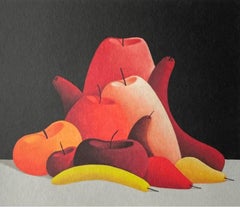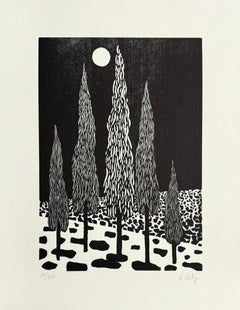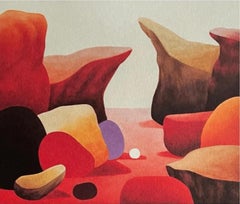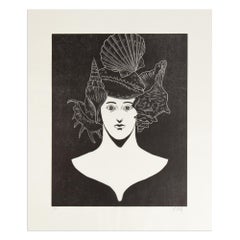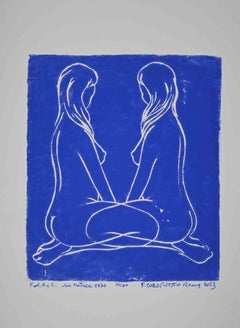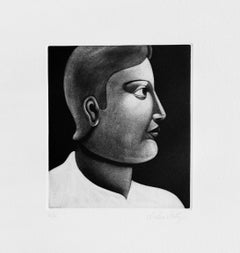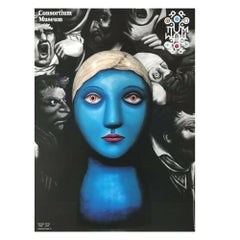Nicolas Party Art
to
9
9
2
STILL LIFE (RED), BY NICOLAS PARTY (2023)
By Nicolas Party
Located in London, GB
NICOLAS PARTY
STILL LIFE (RED), 2023
4 Colour offset print on thick matte paper.
30 × 30 cm
Edition of 100
Produced by MUSEUM FRIEDER BURDA.
Category
21st Century and Contemporary Contemporary Nicolas Party Art
Materials
Lithograph
Trees
By Nicolas Party
Located in London, GB
Woodcut on BFK Rives paper, produced in 2020. Edition of 100. Mint condition, unframed. Signed and numbered in pencil by Nicolas Party.
Category
2010s Contemporary Nicolas Party Art
Materials
Woodcut
STILL LIFE (BLUE), BY NICOLAS PARTY (2023)
By Nicolas Party
Located in London, GB
NICOLAS PARTY
STILL LIFE (BLUE), 2023
4 Colour offset print on thick matte paper.
30 × 30 cm
Edition of 100
Produced by MUSEUM FRIEDER BURDA.
Category
21st Century and Contemporary Contemporary Nicolas Party Art
Materials
Lithograph
STILL LIFE (ROCKS), BY NICOLAS PARTY (2023)
By Nicolas Party
Located in London, GB
NICOLAS PARTY
STILL LIFE (ROCKS), 2023
4 Colour offset print on thick matte paper.
30 × 30 cm
Edition of 100
Produced by MUSEUM FRIEDER BURDA.
Category
21st Century and Contemporary Contemporary Nicolas Party Art
Materials
Lithograph
Nicolas Party, Portrait of a Seahorse Necklace - Original Woodcut, Signed Print
By Nicolas Party
Located in Hamburg, DE
Nicolas Party (Swiss, b. 1980)
Portrait of a Seahorse Necklace, 2021
Medium: Woodcut on HM-5 gampi-shi
Dimensions: 28.3 × 24.1 cm (11 1/10 × 9 ½ in)
Edition of 100 + 8 AP: Hand-signe...
Category
21st Century and Contemporary Contemporary Nicolas Party Art
Materials
Woodcut
Nicolas Party, Portrait with Shells - Original Woodcut, Signed Print
By Nicolas Party
Located in Hamburg, DE
Nicolas Party (Swiss, b. 1980)
Portrait with Shells, 2021
Medium: Woodcut on HM-5 Gampi-shi
Dimensions: 45.7 x 38.1 cm (18 x 15 inches)
Edition of 50: Hand-signed and numbered
Condit...
Category
21st Century and Contemporary Contemporary Nicolas Party Art
Materials
Woodcut
Portrait of a Seahorse Necklace
By Nicolas Party
Located in Bristol, GB
Woodcut on HM-5 gami-shi
AP of 8 aside, from the main edition of 100
Signed and numbered on the front, signed on accompanying book
Mint. Comes in original packaging with accompanying...
Category
21st Century and Contemporary Contemporary Nicolas Party Art
Materials
Woodcut
Profile (Portrait)
By Nicolas Party
Located in London, GB
A mezzotint on Velin Arches paper, produced in 2016. Edition of 15. Signed and numbered in pencil by Nicolas Party.
Category
2010s Contemporary Nicolas Party Art
Materials
Mezzotint
Untitled (Oyster) By Nicolas Party
By Nicolas Party
Located in London, GB
Untitled (Oyster)
By Nicolas Party
2011
Nicholas Party is a contemporary Swiss-born artist celebrated for his distinctive and colorful works encompassing painting, sculpture, and ...
Category
21st Century and Contemporary Contemporary Nicolas Party Art
Materials
Paper
Related Items
The Encounter - Woodcut by Ferdinando Codognotto - 2023
Located in Roma, IT
The encounter is an artwork realized by Ferdinando Codognotto in 2023.
Woodcut based on stencil of 1971.
50 x 36 cm.
Hand signed in the lower right margin.
Good condition.
Category
2010s Modern Nicolas Party Art
Materials
Woodcut, Paper
H 19.69 in W 14.18 in D 0.08 in
CHINESE RHODODENDRONS Hand Drawn Lithograph, Watercolor Floral, Pastel Colors
By Glenny Brazy
Located in Union City, NJ
CHINESE RHODODENDRONS is an original hand drawn lithograph printed using hand lithography techniques on archival Arches paper 100% acid free. Lovely watercolor floral...
Category
1980s Contemporary Nicolas Party Art
Materials
Lithograph
"Gertrude" - Eleven Color Woodcut on Laid Rice Paper 2/45
Located in Soquel, CA
"Gertrude" - Eleven Color Woodcut on Laid Rice Paper 2/45
Portrait of a woman by artist, Dan Miller (American, b. 1928) made by layers of color in woodcuts in Miller's signature sty...
Category
1980s Contemporary Nicolas Party Art
Materials
Rice Paper, Laid Paper, Woodcut
Lord on the Sand Castle - XX century Black & White Woodcut Print
By Franciszek Bunsch
Located in Warsaw, PL
Illustration for Jules de la Medelen's "Lord on the Sand Castle" ("Le Marquis Des Saffras")
FRANCISZEK BUNSCH (born in 1926) Franciszek Bunsch was born in Bielsko in 1926. He studie...
Category
1950s Contemporary Nicolas Party Art
Materials
Paper, Woodcut
Virgin and Child.
By Eric Gill
Located in Storrs, CT
. Wood engraving. Physick catalog 827. 5 3/4 x 2 3/4 (sheet 8 1/16 x 3 7/16). Proof printed on simili-Japan paper with one side deckle edge. Unsigned.
Eric Gill was a painter, scu...
Category
1930s Modern Nicolas Party Art
Materials
Engraving, Woodcut
"Paricutin (Volcano in Michoacan, Mexico)" Woodcut & Monotype signed by Summers
By Carol Summers
Located in Milwaukee, WI
"Paricutin (Volcano in Michoacan, Mexico)" is a woodcut and monotype signed by Carol Summers. In the image, an abstracted volcano erupts in a joyous burst of purples and oranges. The playfulness of the image is enhanced by Summers' signature printmaking technique, which allows the ink from the woodblock to seep through the paper, blurring the edges of each form.
Art: 8 x 11 in
Frame: 17 x 19 in
Carol Summers (1925-2016) has worked as an artist throughout the second half of the 20th century and into the first years of the next, outliving most of his mid-century modernist peers. Initially trained as a painter, Summers was drawn to color woodcuts around 1950 and it became his specialty thereafter. Over the years he has developed a process and style that is both innovative and readily recognizable. His art is known for it’s large scale, saturated fields of bold color, semi-abstract treatment of landscapes from around the world and a luminescent quality achieved through a printmaking process he invented.
In a career that has extended over half a century, Summers has hand-pulled approximately 245 woodcuts in editions that have typically run from 25 to 100 in number. His talent was both inherited and learned. Born in 1925 in Kingston, a small town in upstate New York, Summers was raised in nearby Woodstock with his older sister, Mary. His parents were both artists who had met in art school in St. Louis. During the Great Depression, when Carol was growing up, his father supported the family as a medical illustrator until he could return to painting. His mother was a watercolorist and also quite knowledgeable about the different kinds of papers used for various kinds of painting. Many years later, Summers would paint or print on thinly textured paper originally collected by his mother.
From 1948 to 1951, Carol Summers trained in the classical fine and studio arts at Bard College and at the Art Students League of New York. He studied painting with Steven Hirsh and printmaking with Louis Schanker. He admired the shapes and colors favored by early modernists Paul Klee (Sw: 1879-1940) and Matt Phillips (Am: b.1927- ). After graduating, Summers quit working as a part-time carpenter and cabinetmaker (which had supported his schooling and living expenses) to focus fulltime on art. That same year, an early abstract, Bridge No. 1 was selected for a Purchase Prize in a competition sponsored by the Brooklyn Museum.
In 1952, his work (Cathedral, Construction and Icarus) was shown the first time at the Museum of Modern Art in New York City in an exhibition of American woodcuts. In 1954, Summers received a grant from the Italian government to study for a year in Italy. Woodcuts completed soon after his arrival there were almost all editions of only 8 to 25 prints, small in size, architectural in content and black and white in color. The most well-known are Siennese Landscape and Little Landscape, which depicted the area near where he resided. Summers extended this trip three more years, a decision which would have significant impact on choices of subject matter and color in the coming decade.
After returning from Europe, Summers’ images continued to feature historical landmarks and events from Italy as well as from France, Spain and Greece. However, as evidenced in Aetna’s Dream, Worldwind and Arch of Triumph, a new look prevailed. These woodcuts were larger in size and in color. Some incorporated metal leaf in the creation of a collage and Summers even experimented with silkscreening. Editions were now between 20 and 50 prints in number. Most importantly, Summers employed his rubbing technique for the first time in the creation of Fantastic Garden in late 1957.
Dark Vision of Xerxes, a benchmark for Summers, was the first woodcut where Summers experimented using mineral spirits as part of his printmaking process. A Fulbright Grant as well as Fellowships from the Louis Comfort Tiffany Foundation and the Guggenheim Foundation followed soon thereafter, as did faculty positions at colleges and universities primarily in New York and Pennsylvania. During this period he married a dancer named Elaine Smithers with whom he had one son, Kyle. Around this same time, along with fellow artist Leonard Baskin, Summers pioneered what is now referred to as the “monumental” woodcut. This term was coined in the early 1960s to denote woodcuts that were dramatically bigger than those previously created in earlier years, ones that were limited in size mostly by the size of small hand-presses. While Baskin chose figurative subject matter, serious in nature and rendered with thick, striated lines, Summers rendered much less somber images preferring to emphasize shape and color; his subject matter approached abstraction but was always firmly rooted in the landscape.
In addition to working in this new, larger scale, Summers simultaneously refined a printmaking process which would eventually be called the “Carol Summers Method” or the “ Carol Summers Technique”. Summers produces his woodcuts by hand, usually from one or more blocks of quarter-inch pine, using oil-based printing inks and porous mulberry papers. His woodcuts reveal a sensitivity to wood especially its absorptive qualities and the subtleties of the grain. In several of his woodcuts throughout his career he has used the undulating, grainy patterns of a large wood plank to portray a flowing river or tumbling waterfall. The best examples of this are Dream, done in 1965 and the later Flash Flood Escalante, in 2003. In the majority of his woodcuts, Summers makes the blocks slightly larger than the paper so the image and color will bleed off the edge.
Before printing, he centers a dry sheet of paper over the top of the cut wood block or blocks, securing it with giant clips. Then he rolls the ink directly on the front of the sheet of paper and pressing down onto the dry wood block or reassembled group of blocks. Summers is technically very proficient; the inks are thoroughly saturated onto the surface of the paper but they do not run into each other. The precision of the color inking in Constantine’s Dream in 1969 and Rainbow Glacier in 1970 has been referred to in various studio handbooks. Summers refers to his own printing technique as “rubbing”. In traditional woodcut printing, including the Japanese method, the ink is applied directly onto the block. However, by following his own method, Summers has avoided the mirror-reversed image of a conventional print and it has given him the control over the precise amount of ink that he wants on the paper. After the ink is applied to the front of the paper, Summers sprays it with mineral spirits, which act as a thinning agent. The absorptive fibers of the paper draw the thinned ink away from the surface softening the shapes and diffusing and muting the colors. This produces a unique glow that is a hallmark of the Summers printmaking technique. Unlike the works of other color field artists or modernists of the time, this new technique made Summers’ extreme simplification and flat color areas anything but hard-edged or coldly impersonal.
By the 1960s, Summers had developed a personal way of coloring and printing and was not afraid of hard work, doing the cutting, inking and pulling himself. In 1964, at the age of 38, Summers’ work was exhibited for a second time at the Museum of Modern Art. This time his work was featured in a one-man show and then as one of MoMA’s two-year traveling exhibitions which toured throughout the United States. In subsequent years, Summers’ works would be exhibited and acquired for the permanent collections of multiple museums throughout the United States, Europe and Asia. Summers’ familiarity with landscapes throughout the world is firsthand. As a navigator-bombardier in the Marines in World War II, he toured the South Pacific and Asia.
Following college, travel in Europe and subsequent teaching positions, in 1972, after 47 years on the East Coast, Carol Summers moved permanently to Bonny Doon in the Santa Cruz Mountains in Northern California. There met his second wife, Joan Ward Toth, a textile artist who died in 1998; and it was here his second son, Ethan was born. During the years that followed this relocation, Summers’ choice of subject matter became more diverse although it retained the positive, mostly life-affirming quality that had existed from the beginning. Images now included moons, comets, both sunny and starry skies, hearts and flowers, all of which, in one way or another, remained tied to the landscape.
In the 1980s, from his home and studio in the Santa Cruz mountains, Summers continued to work as an artist supplementing his income by conducting classes and workshops at universities in California and Oregon as well as throughout the Mid and Southwest. He also traveled extensively during this period hiking and camping, often for weeks at a time, throughout the western United States and Canada. Throughout the decade it was not unusual for Summers to backpack alone or with a fellow artist into mountains or back country for six weeks or more at a time. Not surprisingly, the artwork created during this period rarely departed from images of the land, sea and sky. Summers rendered these landscapes in a more representational style than before, however he always kept them somewhat abstract by mixing geometric shapes with organic shapes, irregular in outline. Some of his most critically acknowledged work was created during this period including First Rain, 1985 and The Rolling Sea, 1989. Summers received an honorary doctorate from his alma mater, Bard College in 1979 and was selected by the United States Information Agency to spend a year conducting painting and printmaking workshops at universities throughout India. Since that original sabbatical, he has returned every year, spending four to eight weeks traveling throughout that country.
In the 1990s, interspersed with these journeys to India have been additional treks to the back roads and high country areas of Mexico, Central America, Nepal, China and Japan. Travel to these exotic and faraway places had a profound influence on Summers’ art. Subject matter became more worldly and non-western as with From Humla to Dolpo, 1991 or A Former Life of Budha, 1996, for example. Architectural images, such as The Pillars of Hercules, 1990 or The Raja’s Aviary, 1992 became more common. Still life images made a reappearance with Jungle Bouquet in 1997. This was also a period when Summers began using odd-sized paper to further the impact of an image.
The 1996 Night, a view of the earth and horizon as it might be seen by an astronaut, is over six feet long and only slightly more than a foot-and-a-half high. From 1999, Revuelta A Vida (Spanish for “Return to Life”) is pie-shaped and covers nearly 18 cubic feet. It was also at this juncture that Summers began to experiment with a somewhat different palette although he retained his love of saturated colors. The 2003 Far Side of Time is a superb example of the new direction taken by this colorist.
At the turn of the millennium in 1999, “Carol Summers Woodcuts...
Category
Early 2000s Contemporary Nicolas Party Art
Materials
Woodcut, Monotype
SCROLLS Signed Lithograph, Jewish History, Dead Sea Scrolls, Red, Gold, Black
By Moshe Castel
Located in Union City, NJ
SCROLLS by the Israeli artist Moshe Castel (1909-1991) is a limited edition lithograph printed using traditional hand lithography techniques on archival Somerset paper 100% acid free. SCROLLS is a dramatic abstract collage, its vertical arrangement depicting a grouping of yellow and gold beige papyrus scroll fragments against a textured background of rich vibrant red and black. Ancient alphabet symbols written on the parchment are visible resembling Aramaic letters which create a mystical quality evoking the biblical history of the Dead Sea Scrolls. Aramaic was once the main language of the Jews and appears in some of the Dead Sea Scrolls. It is closely related to Hebrew with the script being very similar.
In SCROLLS, Moshe Castel creates a very aesthetically appealing and captivating contemporary arrangement of ancient Jewish symbolism.
Print size - 29.75 x 21.5 in. unframed, excellent condition, vivid colors, pencil signed by Moshe Castel
Edition size - 150, plus proofs
Year published - 1981
Printer - JK Fine Art Editions Co., NY
Moshe Elazar Castel born in Jerusalem, Ottoman Palestine, in 1909, to Rabbi Yehuda Castel and his wife Rachel. The family was descended from Spanish Jews from Castile who immigrated to the Holy Land after the expulsion of the Jews from Spain in 1492. Castel attended his father’s school until the age of 13. He went on to study at the Bezalel Art School in Jerusalem, where he was encouraged by his teacher to study in Paris furthering his art education at the Academie Julian and Ecole de Louvre in Paris. He was greatly influenced by European masters Rembrandt, Velasquez, Delacroix and Courbert after spending his days copying their works hanging in the Louvre. Castel returned to Palestine at the onset of WWII. The subject of Castel’s early paintings were scenes of Sephardic Jews in the Holy Land. In 1947, Castel helped to found the "New Horizons" (Ofakim Hadashim) group together with Yosef Zaritsky, Yehezkel Streichman...
Category
1980s Contemporary Nicolas Party Art
Materials
Lithograph
Robert Greenhalf, Berwick’s Swans and Lapwings, Limited Edition Print, Bird Art
Located in Deddington, GB
Robert Greenhalf
Berwick’s Swans and Lapwings
Limited Edition Print
Woodcut on Paper
Edition of 100
Paper Size: H 38.5cm x W 41 cm
Image Size: H 27.5c...
Category
21st Century and Contemporary Contemporary Nicolas Party Art
Materials
Paper, Woodcut
Soup Cans
By Banksy
Located in London, GB
Soup Cans, 2005
Offset lithograph on paper, mounted to aluminium
Annotated with the artist's signature stamp, lower right on recto
Presented in bespoke persp...
Category
Early 2000s Contemporary Nicolas Party Art
Materials
Lithograph
Wakeby Island, Woodcut Print by Michael Mazur
By Michael Mazur
Located in Long Island City, NY
Artist: Michael Mazur, American (1935 - 2009)
Title: Wakeby Island
Year: circa 1990
Medium: Color woodcut with chine collé, signed and numbered in pencil
Edition: 15
Image Size: 15 x...
Category
Late 20th Century Contemporary Nicolas Party Art
Materials
Woodcut
Once upon a time in London, Night, Vincent Van Gogh, Big Ben, Dog, Night Walk
By Mychael Barratt
Located in Deddington, GB
A limited edition woodcut on paper print by Mychael Barratt of Vincent Van Gogh on a night walk though London, as blue, turquoise and browns outline Big Ben and the Parliament in the distance.
Additional information:
Mychael Barratt
Once upon a time in London, Night [2023]
Woodcut on paper
Signed and titled in pencil
Numbered from the edition of 100
Please note that insitu images are purely an indication of how a piece may look
Please note sheet sizes may differ.
Image size:
Height: 28cm
Width: 28cm
Complete size of sheet:
Height: 39.5cm
Width: 38.2cm
Depth: 0.1cm
ARTIST BIO:
Mychael Barratt was born in Toronto, Canada, however, considers himself to be a Londoner since arriving for what was supposed to be a two-week stay thirty years ago. He is a narrative artist whose work is steeped in imagery relating to art history, literature, theatre and everything else that overfills his bookshelves. He was an artist in residence for Shakespeare’s Globe Theatre...
Category
2010s Contemporary Nicolas Party Art
Materials
Paper, Woodcut
H 15.56 in W 15.04 in D 0.04 in
Lord on the Sand Castle - XX century Black & White Woodcut Print
By Franciszek Bunsch
Located in Warsaw, PL
Illustration for Jules de la Medelen's "Lord on the Sand Castle" ("Le Marquis Des Saffras")
FRANCISZEK BUNSCH (born in 1926) Franciszek Bunsch was born in Bielsko in 1926. He studie...
Category
1950s Contemporary Nicolas Party Art
Materials
Paper, Woodcut
Previously Available Items
Profile (Portrait)
By Nicolas Party
Located in London, GB
A mezzotint on Velin Arches paper, produced in 2016. Edition of 15. Signed and numbered in pencil by Nicolas Party.
Category
2010s Contemporary Nicolas Party Art
Materials
Mezzotint
Head
By Nicolas Party
Located in 'S-GRAVENHAGE, ZH
This print was created on the occasion of the artist's exhibition at the Consortium Museum, "Boilly", titled after the prolific French artist Louis-Léopold Boilly (1761-1845), a pain...
Category
2010s Nicolas Party Art
Materials
Screen
Untitled
By Nicolas Party
Located in Bristol, GB
Acrylic on glass vase
12 x 20 cm
Unsigned and unnumbered
Mint
Published by Dimes, New York, Spring Water Benefit for Dig Deep, May 15, 2018
Category
21st Century and Contemporary Contemporary Nicolas Party Art
Materials
Acrylic, Glass
Rocks II
By Nicolas Party
Located in London, GB
Mezzotint
18 7/10 × 13 3/5 in (47.6 × 34.6 cm)
Hand signed and numbered by the artist, recto.
Sold unframed, in mint condition.
Category
2010s Contemporary Nicolas Party Art
Materials
Mezzotint
Untitled
By Nicolas Party
Located in Bristol, GB
Watercolour, pastel, gold leaf and oil on card
Unique, from a series
Dedicated on the back (name concealed), along with Christmas message that reads 'Merry Christmas and Happy New Ye...
Category
21st Century and Contemporary Contemporary Nicolas Party Art
Materials
Watercolor
Nicolas Party art for sale on 1stDibs.
Find a wide variety of authentic Nicolas Party available for sale on 1stDibs. If you’re browsing the collection of art to introduce a pop of color in a neutral corner of your living room or bedroom, you can find work that includes elements of orange and other colors. You can also browse by medium to find art by Nicolas Party in woodcut print, paint, watercolor and more. Much of the original work by this artist or collective was created during the 21st century and contemporary and is mostly associated with the contemporary style. Not every interior allows for large Nicolas Party, so small editions measuring 6 inches across are available. Nicolas Party prices can differ depending upon medium, time period and other attributes. On 1stDibs, the price for these items starts at $1,500 and tops out at $9,862, while the average work can sell for $5,608.
